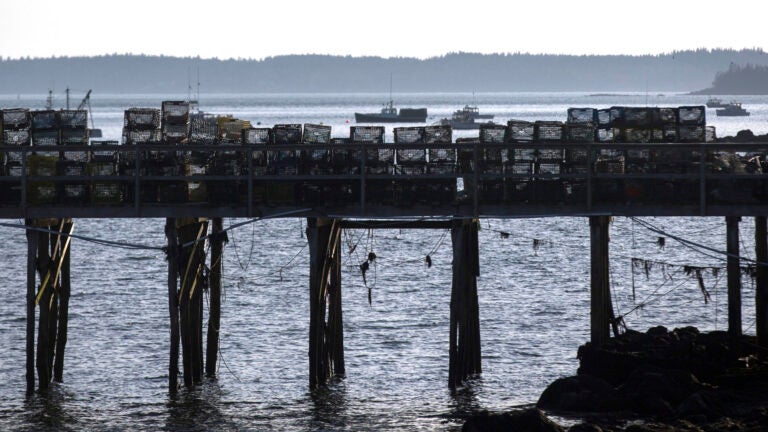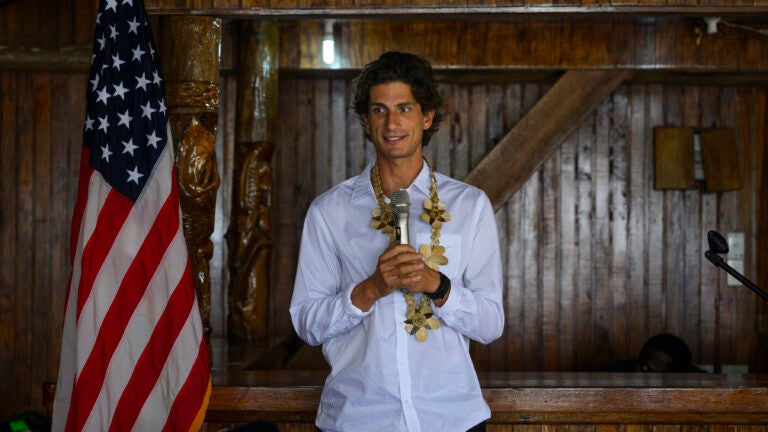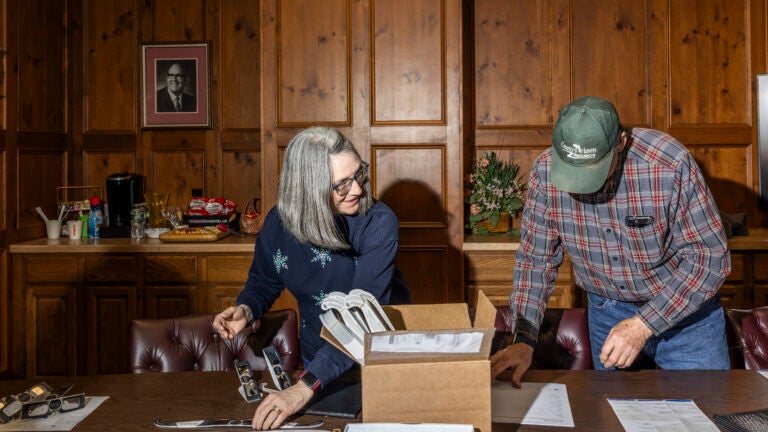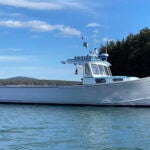This strange, lobster-fueled border dispute off Maine has been simmering long before Trump
Before the recent Border Patrol operations rankled Canadians, the Machias Seal Island dispute has been a story of puffins, lobster, climate change, and one mythically tall Mainer.

For all the attention being paid on southern immigration, the shared border itself between the United States and Mexico is actually something on which all sides have agreed for decades.
However, the efforts by President Donald Trump’s administration to ramp up immigration enforcement all along the perimeter of the United States recently shed light on a uniquely unsettled border dispute much closer to home. Machias Seal Island, a 20-acre island 10 miles off the coast of Maine, is claimed by both Canada and the United States.
“We have a 5,525-mile-long border with Canada, and all but this little chunk of it is firmly established and accepted by both countries,” says Stephen Kelly, a research scholar at Duke University and former diplomat who has long urged the two neighbors to settle the disagreement.
The conflict was recently cast into international focus after reports that U.S. Border Patrol agents were stopping Canadian fishermen in the area, causing a modest uproar in the Great White North. It was likely the first time many Americans had even heard of Machias Seal Island, if the story broke through at all.
Once dubbed the “Coldest War,” the quiet dispute over the tiny, meadow-topped island and its surrounding waters has been simmering for more than two centuries, consisting of puffins, lobster, and a few legendarily provincial Mainers.
‘He supposedly took them on single-handedly’
“Border disputes do not go away; they fester,” Kelly wrote in a 2002 New York Times op-ed.
And this dispute has been festering since the Revolutionary War. The 1783 Treaty of Paris, which officially ended the war, gave the 13 independent colonies rule over all islands within 20 leagues, or roughly 70 miles, of the American shore. Machias Seal Island is less than 10 miles from what is now the town of Cutler, Maine.
However, the treaty exempted islands that had been part of Nova Scotia, and Canadians say Machias Seal Island was included in a 1621 land grant deeding the province to Sir William Alexander — though the grant’s wording is imprecise.
Anyway, the Canadians asserted their claim to the small, treeless, puffin-inhabited patch of rocks. The then-British colony constructed a lighthouse on the island in 1832 and made sure to staff it regularly with Canadian keepers. Even though the lighthouse is now automated, the Canadian government continues to keep lighthouse keepers stationed there “for sovereignty purposes.” They’ve also put up a warning sign displaying the county’s name and maple leaf flag.
The United States didn’t formally assert its claim to the island until 1971.
Machias Seal Island wasn’t the only territorial dispute between the United States and Canada in the Gulf of Maine area. However, the two countries submitted the other claims to the International Court of Justice at the Hague to be settled in 1984. The agreement did not include Machias Seal Island or its surrounding waters, known as the Grey Zone. Canada refused earlier arbitration proposals that included the island, claiming that to even broach the topic would compromise their claim.

Puffins on Machias Seal Island in 1996.
Despite the lack of agreement, the dispute over the island itself hasn’t resulted in any major flash points. Rather, it mostly has amounted to passive aggressive displays.
Barna Norton, a by–all–accounts crusty sea captain who died in 2004, claimed he was willed Machias Seal Island by his 7-foot-tall great-grandfather, Barna “Tall Barney” Beal, who was said to have once fought off British patrols in 1865 and claimed the island for himself.
“He supposedly took them on single-handedly and chased them off,” Kelly said of Beal. “And this is somehow his claim that the island is his.”
According to the lore, Beal willed the island to his first descendant named “Barna,” purportedly justifying Norton’s claim. A retired appliance salesman, Norton led group tours on his 30-foot boat, “Chief,” to see the island’s abundant puffin and tern populations during the summer for decades.
“The island belongs to me, but everyone is welcome,” the straw-hatted octogenarian told the Associated Press in 1998.
According to The Boston Globe, the Canadian government would send Norton a letter every few years telling him he could no longer land on the island. However, the U.S. State Department backed up Norton in 1983, sending him a letter that said he had “every right to ignore any regulation that Canada might pretend to set for Machias Seal Island.”
That he did.
Every Fourth of July, Norton reportedly would land ashore, parade around with an American flag proclaiming that the island belonged to the United States, and ask the Canadian lighthouse keepers for rent.

Barna Norton with his boat, “Chief,” which was registered to Machias Seal Island, USA, in 1996
Tony Diamond, a University of New Brunswick biology professor who frequented Machias Seal Island to see the puffins, told the National Post in 2012 that he used to counter Norton’s annual Independence Day forays by marking tern nests with small, Canadian flags.
“I took great pleasure in that,” Diamond told the Post. “[Norton] would have to walk past about 100 of these things.”
Tour boats taking birdwatchers to see the puffin colony continue to operate out of both Maine and Grand Manan Island, which is part of New Brunswick and, at its closest point, less than 12 miles away from Machias Seal Island. The popular tours run $115 to $150 per person and sell out months in advance.
Kelly, who was posted twice in Canada near the end of his 28-year career with the U.S. Foreign Service, called such minor squabbles “back-burner stuff” that didn’t occupy much of their time at the embassy. The two sides appeared to come to some mutual, if unspoken, agreement of coexistence when it came to the island itself.
The waters around Machias Seal Island, however, are another story.
Red hot tensions in the Grey Zone
In 2002, Canada’s fisheries department relaxed regulations to allow its Grand Manan Island lobstermen to fish in the Grey Zone in the summer.
“In some ways, I think that’s when the problem started to get more serious,” Kelly said.
Previously, Maine lobstermen had the area to themselves in the summer, as their Canadian counterparts traditionally halted their fishing season from the end of June until October. According to Kelly, the Grey Zone was colloquially known to Mainers as the “gravy zone,” given how lobstermen were able to clean up in the absence of any Canadians. However, the change in 2002 allowing local Canadians to fish the Grey Zone in the summer put lobstermen from the two neighboring countries in direct competition.
Additionally, the differing fishing regulations imposed by the two countries is a source of tension. While Maine lobstermen aren’t allowed to keep lobsters over a certain size, Canadians have no such limit. And to own a fishing license in Maine, the license-holder has to be on the boat, which keeps the industry locally based. The same isn’t true in Canada, allowing license-owners to sublet out their boats.
“You could be a Nova Scotia company with the rights to a license,” Kelly said. “You don’t have to be the one out there on the boat actually doing the fishing.”
According to Kelly, the Grey Zone has subsequently seen more Canadian boats, as well as ones that are larger and based from farther away, fishing in the area. Amid irritation among Maine lobstermen, New Brunswick Fisheries Minister Rick Doucet acknowledged to the CBC in 2015 that “the boats coming over from Nova Scotia have upped the ante a little bit.”

Maine Marine Patrol specialist Mark Murry speaks with lobsterman Brian Cates in Cutler, Maine, in 2015.
Maine fishermen have also accused the Canadians of careless overfishing. Several estimated to the Bangor Daily News that the number of Canadian fishermen in the Grey Zone had doubled in the past year up to at least 40 (which is the same number of Maine-based lobstermen working the area).
“The Maine fishermen complain about their lines being cut, their traps being hauled off,” Kelly said.
In one particularly noteworthy case, Patrick Feeney, a Maine lobsterman, had his thumb ripped off in 2007 after it got caught in equipment while he was jostling with a Canadian for territory, according to MacLeans.
“Somebody is going to get killed,” John Drouin, the Maine lobsterman in charge of the local district, told the Toronto-based magazine in 2015. “We’ve had bad years in the past and got lucky, but this is the worst year I’ve ever seen.”
‘Climate change is going to kill us’
These increased tensions above the surface haven’t happened in a vacuum.
The change in regulations also preceded changing natural dynamics in the area. Climate change has warmed waters off Maine to a temperature that is more favorable to lobsters, just as it has made the ocean off Southern New England inhospitably warm.
Maine’s lobster catch has subsequently seen significant increases in recent years, both in quantity and value, as a result of climate change (as well as the local industry’s conservation practices). The biggest jump in value occurred in 2014, when the lobster catch off Maine’s coast surged to $459 million, $89 million more than the 2013 total.
However, the industry saw a drastic drop off last year, when the state’s total lobster haul dropped from 132 million pounds in 2016 to less than 111 million pounds in 2017, a difference of more than $100 million. As some lobstermen recently told The New York Times, there are fears the waters are actually getting too warm — and that the fate of the Southern New England lobster industry could soon be coming for them.
“Climate change really helped us for the last 20 years,” Dave Cousens, the former president of the Maine Lobstermen’s Association, told the Times. “Climate change is going to kill us, in probably the next 30.”
In fact, researchers say the Gulf of Maine is warming faster than 99 percent of oceans around the world and that the lobster population could decrease from 40 to 62 percent by 2050, as the crustaceans move toward both deeper and more northeastern (i.e. Canadian) waters.
The increasing scarcity has only contributed to heightened pressure in the waters around Machias Seal Island, according to Kelly.
“There’s no doubt that there has been an increased presence in the Grey Zone, and the fact that there’s not a clearly delineated boundary has led to ambiguity and, potentially, to more clashes,” he said.
Another front in the conflict opens
If climate change and managerial disputes weren’t already enough, the Trump administration has opened another dimension to the conflict. Amid already inflamed tensions with Canada over trade and increased border patrol efforts across the country, Canadian fishermen complained last month that U.S. agents were stopping them in the Grey Zone.
“Typical American bullies,” Laurence Cook, the chair of the Grand Manan Fishermen’s Association, wrote at the time on Facebook, adding the agents claimed to be “looking for illegal immigrants.”
Asserting that the stops occurred in Canadian waters, a Global Affairs Canada spokesman said they were launching an investigation into the incidents. Reached again last week, the agency said they had no updates and were still investigating.
Several longtime lobstermen operating out of nearby Cutler, Maine, recently told the Portland Press Herald that they had seen Border Patrol agents operating offshore in the past, but “not on this scale.” Cook says American agents stopped at least 10 Canadian fishing boats in the Grey Zone the last two weeks of June.
Stephanie Malin, a spokeswoman for U.S. Customs and Border Protection, said the Houlton Sector Border Patrol, which has jurisdiction in Maine, “has routinely conducted patrol operations” off the state’s coast. Malin says the Border Patrol has interviewed 21 Canadian vessels since the beginning of last October, but could not provide any additional data. She declined to answer if they had recently increased their operations — and, if so, why.
The stops in question come as Border Patrol agents broaden their search inland, both locally and nationally. From Washington state to Florida to New England, officers have recently been setting up checkpoints up to 100 miles away from the border, raising alarms from civil liberties groups, given how many people live in that zone.
Recent checkpoints on highways in New Hampshire and Maine have come under particular scrutiny. Vermont has also seen a “steep increase” in immigration-related arrests near the border. The American Civil Liberties Union has argued, in some cases successfully, that the checkpoints violate both state and federal constitutions. The local ACLU branches in three New England states have also sued the government for allegedly ignoring freedom of information requests about the checkpoints in the states.
No arrests have been made in the Grey Zone waters, according to Malin.
“This is not a part of the world where there is a lot of immigration coming from Canada or across the waters,” Kelly said.
Kelly says that the Border Patrol raids, having particularly rankled the Canadian side, are just another aggravating factor in a dispute in which both sides are pretty dug in.
“The brouhaha it’s given rise to shows that this issue isn’t just going to go away,” he said. “It’s going to be a problem until both countries devote the resources to solving it.”
Kelly understands that neither country wants to risk losing access to a valuable fishery, if they put the case up to international arbitration. But he thinks they need to find an “equitable way” to settle the dispute before something “really ugly happens.”







